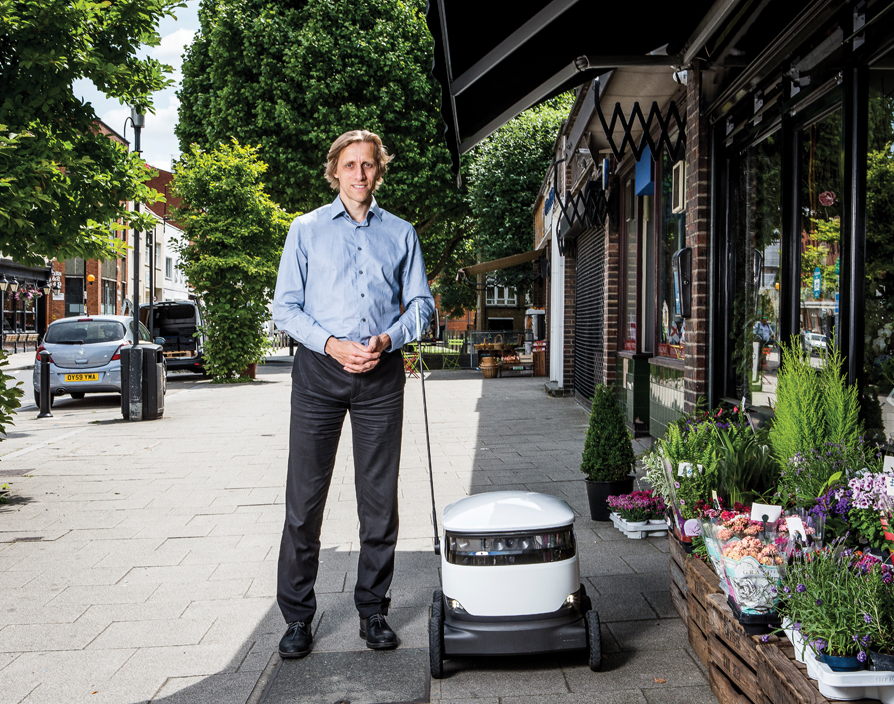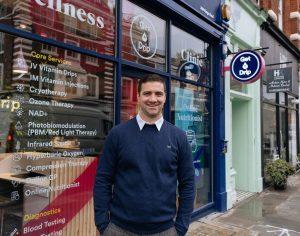Cliches are anathema for entrepreneurs: serial founders are living proof that lightning can and often does strike twice. But there are few who can claim to have been part of the driving force behind a continent’s most significant unicorn and even fewer who can claim all of the parts required to build another. Evidently, Ahti Heinla is the exception – not only was the Estonian entrepreneur the technical lead that oversaw the development of Skype but now, as the co-founder and CTO of Starship Technologies, he is revolutionising deliveries by bringing its fleet of autonomous bots to cities around the world.
It’s no surprise Heinla came to play such a significant role in the Estonian entrepreneurial ecosystem – his young life was steeped in tech and he literally learned to code at his parents’ knees. “Both of my parents were computer programmers,” he says. “In fact they taught me to program when I was ten-years-old so this is a way of life for me.” And as he matured, the adolescent Heinla added to his technical skills by combining his passions for programming and play. “Anytime I had a problem, I tried to solve that using software,” he says. “This led me to develop computer games.”
But Heinla wasn’t content with remaining an amateur and throwing together the 1980s equivalent of Flappy Bird. He soon went pro and co-founded the games studio Bluemoon Interactive with his school friends Jaan Tallinn and Priit Kasesalu, giving him a front-row seat as the desktop and home-gaming markets exploded. “The industry is very exciting,” he says. “It’s full of adventure, there is a lot of creativity going on and a fusion of different types of talent, so it’s a lot of fun.” However, over the following decade, the wild frontier of the games market began to be tamed as the larger publishing houses staked their claims. “The game development world was consolidating: only the top games ended up making a profit and that meant the games had to be bigger and bigger to have a chance,” Heinla says. “Essentially we found it hard to keep it commercially viable.”
Fortunately, it wasn’t just the games industry that was transforming. After the collapse of the Soviet Union, Estonia had been forced to rebuild its bureaucracy essentially from scratch. Able to embrace technology in a way that countries with legacy infrastructure weren’t, its capital Tallinn soon established itself as the epicentre of European tech. “It’s hard to predict the way a country will evolve but certainly Estonia has found one of its niches: it’s a tech-savvy nation,” says Heinla. This meant that when the dotcom boom hit the continent, Estonia was effectively ground zero – providing the perfect opportunity for Heinla and his co-founders to pivot into a different profession. “All of the internet was opening up and there were lots of opportunities so it was only natural that we made the switch to making new things,” he says.
Thanks to the emergence of this thriving tech ecosystem, entrepreneurs from elsewhere were eyeing the innovations being cooked up in the country. “Everyday.com was a web portal being developed by a couple of Swedish companies,” Heinla says. “They had just acquired a small web-development company in Estonia and decided to look for a group of top developers over here, which is how they found us.” Not only did this give Heinla and his friends a crash course in developing dotcom tech but it brought them together with the Swedish / Danish entrepreneurial duo Niklas Zennström and Janus Friis – creating one of Europe’s most renowned development teams.

After graduating from Everyday.com, the newly formed group of entrepreneurs had some success building tech like the Fasttrack P2P protocol – which underpinned file-sharing platforms like Kazaa – but they couldn’t possibly have anticipated the impact their next startup would have on the world. “In my experience, it’s always very difficult to predict in the beginning whether a startup is going to be a mega success,” Heinla says. “Skype was no different.”
As is the case with many of the innovations that have come to transform the tech landscape, it was a group of friends chewing over a mutual gripe that led to Skype’s conception. Finding themselves frustrated with the high price of phone calls, in 2003 Heinla and his fellow entrepreneurs began discussing whether it would be possible to offer free voice calls over the internet. After a few back-of-a-napkin calculations to ensure the economics stacked up and some early experiments to trial the tech, development of Skype’s initial platform began in earnest. And when it launched just nine months later, the team’s faith in the idea was quickly vindicated. “We got the first 10,000 users in one day and the first 100,000 users in 20,” says Heinla. “Back in 2003, things didn’t normally happen quite that fast so that was actually a fantastic growth rate.”
Becoming Skype’s chief technical architect, Heinla spent the next five years overseeing the creation of much of its underlying technology. But while the company’s fortunes continued to rise – by 2005 its name was on everybody’s lips, thanks in no small part to its $2.5bn acquisition by eBay – Heinla began to crave the opportunity to once again forge his own path. “I have always been a person to start things, lay the foundations and do the initial work,” he says. “After a while, all of Skype’s products and services were pretty much developed and it was more like fine tuning and growing in numbers.”
In the years that followed his departure from Skype, Heinla not only co-founded Ambient Sound Investments with his fellow Skype engineers, helping to fund startups such as Treatwell and Blip, but he also founded several startups including targetAPI, the provider of predictive content personalisation technology. However, his most ambitious project came about in 2014 when he happened to cross paths with a face from the past – Janus Friis. Since Skype’s acquisition, Friis had co-founded Atomico Ventures and the TV and music streaming startups Joost and Rdio with Zennström but after several solo startups he was now looking for a new joint project to tackle. “We had really enjoyed working with each other and realised we wanted to build a startup together so we started to brainstorm,” says Heinla.

Although they agreed robotics and AI were areas with enormous potential, many of the verticals that received the most attention were those where a startup could have relatively limited impact. “Realistically, to create a self-driving car, the development team needs in the region of $1bn of investment and it’s a very tough market to crack,” says Heinla. “We realised that a small robot is a lot easier to build and is more suitable for a startup, yet still has the potential to have billions of users.” As far as the entrepreneurs could see it, there were three fundamental human needs that could be better catered to by autonomous robots. “The first was agriculture, the second was cleaning and the third was delivery,” Heinla says. “We chose to focus on delivery.”
Thanks to Amazon Prime, online fashion retailers and food delivery startups, demand for deliveries was sky high – but it seemed many entrepreneurs and investors were interpreting this literally. “Pretty much everybody was focusing on developing drone deliveries,” says Heinla. While this excitement is easy to understand given the clear use cases for drones, significant regulatory, security and safety hurdles mean the technology still has a steep hill to climb in order to win the public’s trust. In Heinla and Friis’s eyes, this meant that ground-based bots might actually be able to outmanoeuvre their sky-bound brethren. “We thought a small, ground delivery robot would be more accepted by society,” says Heinla.
Certain they’d hit upon a winning formula, the entrepreneurs co-founded Starship Technologies with the aim of bringing futuristic delivery droids to global high streets. But this was easier said than done: putting together such an ambitious project would require significant technical talent.
Fortunately, thanks to its tech-infused culture and strong academic focus on STEM subjects, Tallinn was awash with great developers – and Starship’s rep was already such that it was easily able to pull them in with its tractor beam. “I was known as one of the founding engineers of Skype so we were definitely the coolest startup being developed in the country,” says Heinla. But the considerable cachet of its founders wasn’t the only draw – ultimately, there’s just a charm to developing droids that few coders can pass up. “Engineers love building robots,” says Heinla. “Building an autonomous bot that uses AI, that’s one of the coolest things that machine-learning engineers can do.”

With the help of this passionate development team, Starship soon had a fleet of prototypes at its disposal and before long began commercial trials in partnership with Just Eat. And the experience it offered these hungry customers was silky smooth. “The consumer orders their food on the platform, just like they would do normally,” Heinla says. “The robot is dispatched to pick up the food from the restaurant, then drives to the customer’s location.” While the robot navigates its way to its destination, the customer can track its progress, safe in the knowledge that their food is locked up nice and safe in its cargo hold. And once it arrives at their doorstep, they receive a message notifying them the delivery is complete. “If you are the right recipient, that message allows you to open up the robot’s cargo compartment and take your stuff,” says Heinla. “Then the robot drives away. It’s as simple as that.”
But offering this painless customer experience requires a lot more going on beneath the hood. Helping the robots to understand the communities they operate in takes a lot of intelligence – both artificial and analogue. When Starship’s tech is introduced to a new location, humans first map the basic area and then the robots are allowed to explore, using their sensors and GPS to flesh out their sense of the local neighbourhood. But even when the area is fully mapped the droids are never completely alone in the world. If one of Starship’s robots ever finds itself unsure of how to proceed – for example wondering when is the best time to cross a busy intersection – it can ask for a helping hand. “In difficult situations the robot stops, calls the human operator and they’ll help it negotiate the situation,” says Heinla.
This combination of machine learning and light-touch human oversight has made Starship’s solution eminently scaleable – which is partly why investors have been clamouring to support it. “Investors want to back startups with big ideas that have a large addressable market,” says Heinla. “Starship stands out and investors love that.” When the startup opened its seed round in January 2017, it drew in a whopping $17.2m right out of the gate from investors including Matrix Partners and Shasta Ventures. When you compare that to the £2.7m series A raised in 2014 by now unicorn Deliveroo, it’s easy to see that investors fully expect Starship to reach the stratosphere.
However, not everyone is as excited about the ubiquitous presence of autonomous robots in cities as investors and engineers. One qualm that is often raised is whether an algorithm can be considered sufficiently infallible to safely operate around humans. “Safety is our main criteria when we decide if our robot can operate in a certain area,” says Heinla. Fortunately, Starship’s bots are specifically engineered so they can safely share public spaces with pedestrians. Not only has their AI been rigorously tested to ensure they won’t crash into obstacles – human or otherwise – but they are intentionally lightweight and have a cruising speed that’s about walking pace. As a result, while rare cases of artificial stupidity in technology like drones or driverless cars could potentially result in injuries or even fatalities, even the most reckless delivery bot would struggle to leave much more than a bruise. “I have specifically tried that myself. We removed all of the safety systems in the robot and had it crash into me,” Heinla says. “It really doesn’t hurt: it’s not an issue.”
Another factor is the inherent unease many people feel around allowing AI to have such a significant influence over our lives. However, when looking at Starship’s WALL-E-esque robot, it’s hard to imagine it playing a pivotal role in the rise of the machines – something that seems like it must have been a conscious design choice. “Oh that was a very deliberate decision,” Heinla admits. “People are afraid of a robot when it looks industrial, makes weird noises and buzzes. But if it looks cute then they really accept them in their lives.” In fact, Starship’s robots have proven incredibly popular with the public. Not only have they stormed up a trend on Instagram as the star of scores of selfies but on the odd occasion one has run into trouble, citizens have swarmed together to provide succour to the stricken droid. “People go bananas about them,” says Heinla.
Without a doubt, scenes like these are set to become much more commonplace. Starship’s vehicles are already operating in ten cities around the world and this is set to surge in the coming months. “Thousands of people have experienced our robotic deliveries so far and obviously we want to turn this into millions quite quickly,” Heinla says. “So this year is going to be the year when we are expanding our services rapidly.”
And Starship has made sure it has the fuel needed to launch into orbit. Fresh from announcing its commercial rollout this April, the startup closed a new seed round in June, securing a $25m cash injection to help it bring its services to neighbourhoods and corporate and university campuses across the US and Europe. Heinla also recently announced he would be focusing on driving the company’s tech as CTO moving forward and handing over the role of CEO to Lex Bayer – a canny move given his previous role as group head of business development, payments and Airbnb for Business at Airbnb. “The appointment of Lex was a natural next step in the company’s growth journey,” Heinla explains. “He has a wealth of experience in scaling tech companies and bringing revolutionary ideas to market.”
Not content with turning the global delivery market upside down, it also seems Starship may also be in the perfect place to help transform our attitudes about robots’ role in society more generally. Just as increased convenience has gradually been driving greater acceptance of AI and automation in other areas, Heinla feels Starship will play a similar role in driving acceptance of robots’ place in our neighbourhoods. “I certainly expect that after some time the same sort of transition will happen,” he says. “People will become used to things being delivered by machines.” ![]()
Share via:


















































